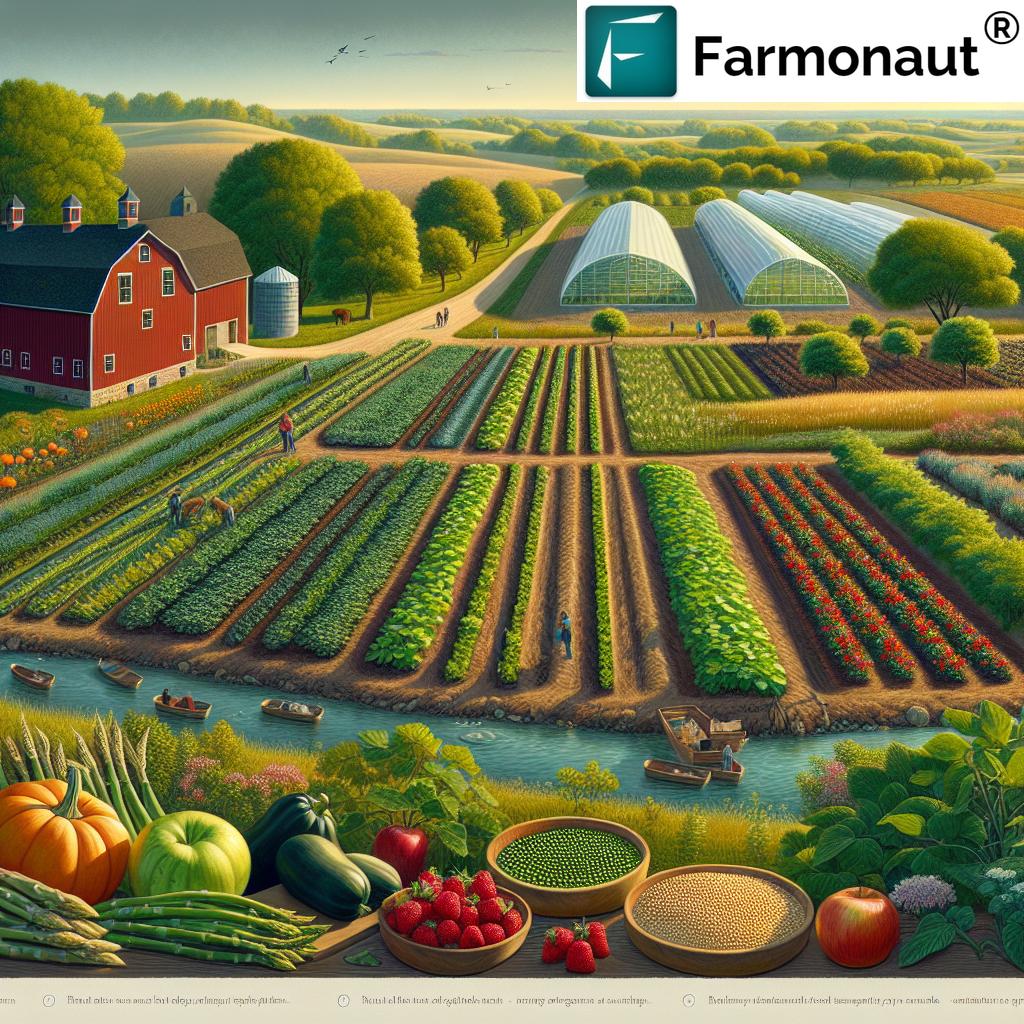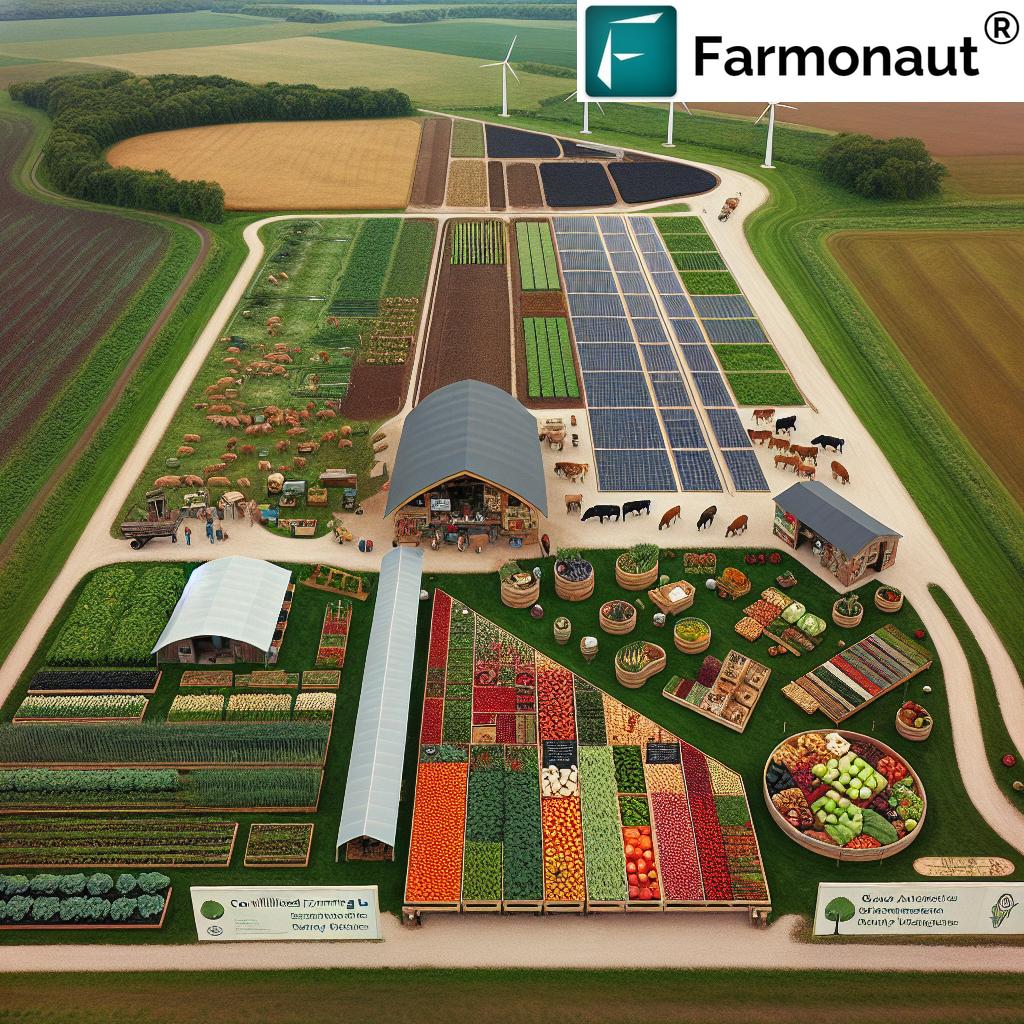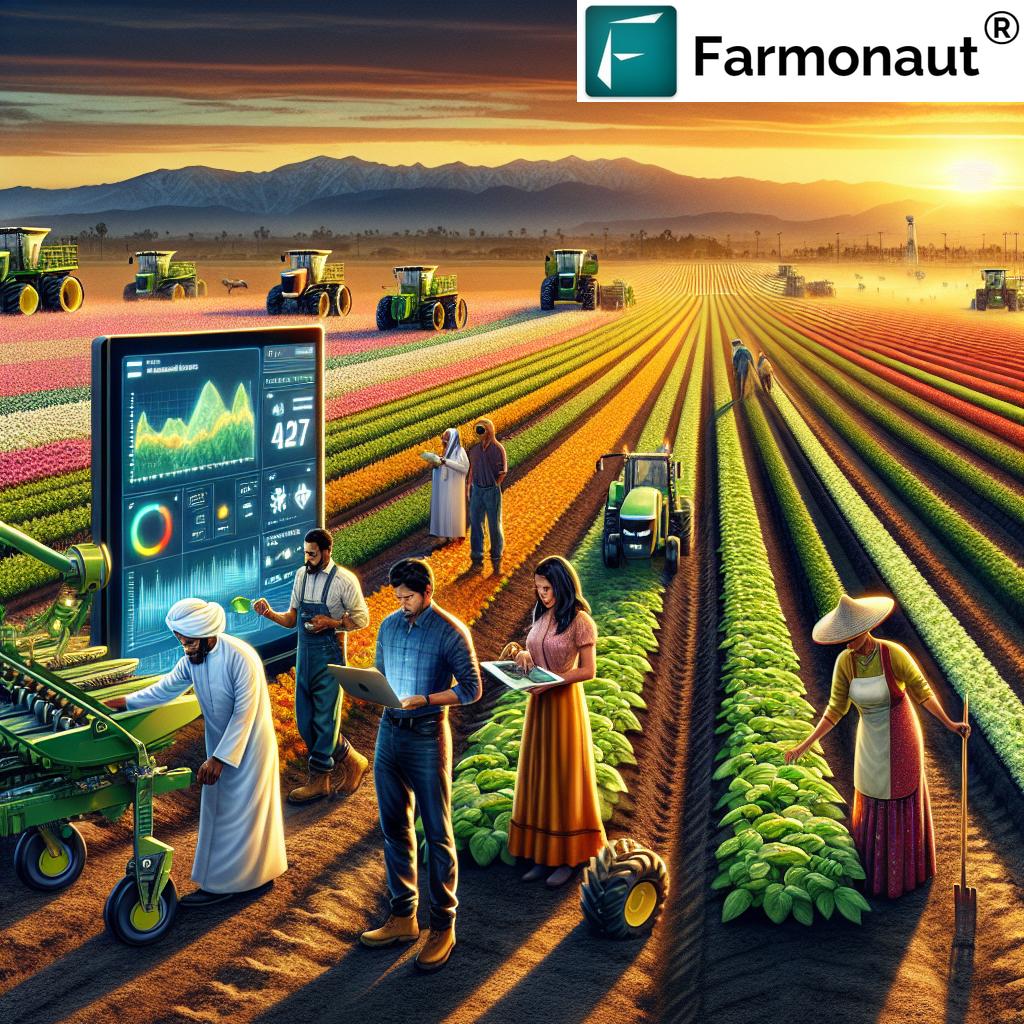Sustainable Farming Revolution: How Wisconsin Farmers Are Embracing Organic Vegetables and Specialty Crops

“Wisconsin farmers transitioning to organic vegetables have increased specialty crop acreage by 30% in the last 5 years.”
In the heart of America’s Dairyland, a quiet revolution is taking place. Wisconsin farmers, long known for their traditional dairy operations, are increasingly turning to sustainable farming practices and embracing a diverse array of organic vegetables and specialty crops. This shift is not just changing the landscape of Wisconsin’s farms but is also reshaping the future of agriculture in the region. In this comprehensive exploration, we’ll delve into the reasons behind this transition, the challenges faced by farmers, and the promising outcomes of these innovative agricultural approaches.
The Changing Face of Wisconsin Agriculture
For generations, Wisconsin has been synonymous with dairy farming. However, recent years have seen a significant shift in the agricultural landscape. Farmers across the state are diversifying their operations, moving away from traditional dairy farming towards more sustainable and economically viable alternatives. This transition is driven by a combination of factors, including:
- Changing consumer preferences towards plant-based diets
- Increasing awareness of environmental sustainability
- Economic pressures on traditional dairy operations
- The need for farm diversification to mitigate risks
As a result, we’re seeing a surge in the cultivation of organic vegetables, specialty crops, and even plant-based protein sources. This shift is not just a trend but a fundamental change in how Wisconsin farmers approach agriculture.
Embracing Organic Vegetable Farming
One of the most significant trends in Wisconsin’s agricultural transformation is the move towards organic vegetable farming. This shift is driven by several factors:
- Growing consumer demand for organic produce
- Higher profit margins compared to conventional farming
- Environmental benefits of organic farming practices
- Healthier soil and improved biodiversity
Farmers like Greg Zwald, who once embraced the life of a dairy farmer, have now transitioned to running pick-your-own-berry enterprises. This shift not only diversifies their income streams but also allows them to tap into the growing market for locally grown, organic produce.
To support farmers in this transition, organizations like the Physicians Committee are providing farm transition grants. These grants are modeled after programs established by lawmakers in Vermont, offering financial assistance to farmers wishing to diversify or transition from one type of farming to another.
The Rise of Specialty Crops
Beyond organic vegetables, Wisconsin farmers are increasingly turning to specialty crops as a means of diversification and increased profitability. Some popular specialty crops include:
- Berries (strawberries, raspberries, blueberries)
- Butternut squash
- Apples
- Asparagus
- Hazelnuts
For instance, Paul Jereczek, a Wisconsin dairy farmer, has started planting hazelnut trees. His motivation? To provide a future for his children on the land, as he doesn’t see a sustainable future in dairy farming alone.
These specialty crops not only offer higher returns per acre but also contribute to the state’s agricultural diversity. They provide farmers with new market opportunities and help meet the growing consumer demand for locally grown, unique produce.
Plant-Based Protein Sources: A New Frontier
As the demand for plant-based proteins continues to rise, Wisconsin farmers are exploring new opportunities in this sector. Crops like chickpeas and mung beans, traditionally grown in states like Oklahoma, are gaining attention for their protein content and versatility.
These legumes offer several advantages:
- High protein content
- Rich in fiber and essential nutrients
- Drought-resistant and suitable for various climates
- Growing market demand for plant-based protein alternatives
By cultivating these crops, Wisconsin farmers are not only diversifying their income streams but also contributing to the growing plant-based food industry.
Fruit and Nut Tree Farming: A Long-Term Investment
Another exciting development in Wisconsin’s agricultural landscape is the increased interest in fruit and nut tree farming. This shift represents a long-term investment in sustainable agriculture. Trees like apple and hazelnut not only provide valuable crops but also offer environmental benefits:
- Carbon sequestration
- Soil erosion prevention
- Habitat creation for wildlife
- Improved water quality through riparian buffers
For example, farmers are planting riparian buffers of trees and shrubs to intercept polluted water running off fields. Hazelnuts, suitable for these buffers, can also provide additional income to farmers, as noted by the U.S. Department of Agriculture.

Farm Diversification Strategies
Farm diversification is at the heart of Wisconsin’s agricultural transformation. Farmers are adopting various strategies to spread risk and increase profitability:
- Crop Rotation: Alternating crops to improve soil health and reduce pest pressures
- Mixed Farming: Combining crop cultivation with livestock rearing
- Value-Added Products: Processing raw farm products into higher-value goods
- Agritourism: Opening farms for tours, pick-your-own experiences, and educational activities
These strategies not only provide additional income streams but also help farmers build resilience against market fluctuations and environmental challenges.
Alternative Agriculture Opportunities
Wisconsin farmers are exploring various alternative agriculture opportunities beyond traditional crops. Some innovative approaches include:
- Mushroom Cultivation: Converting old barns or shipping containers into mushroom growing facilities
- Aquaponics: Combining fish farming with hydroponic vegetable production
- Bee Farming: Producing honey and other bee products while supporting crop pollination
- Hemp Cultivation: Growing hemp for CBD oil, fiber, or seed production
These alternatives offer unique opportunities for farmers to diversify their operations and tap into niche markets.
Sustainable Farming Practices
At the core of Wisconsin’s agricultural revolution is a commitment to sustainable farming practices. These practices not only benefit the environment but also contribute to long-term farm viability:
- Cover Cropping: Planting crops to cover soil between growing seasons
- Reduced Tillage: Minimizing soil disturbance to improve soil health
- Integrated Pest Management: Using natural predators and targeted interventions to control pests
- Water Conservation: Implementing efficient irrigation systems and water management practices
These sustainable practices are crucial for maintaining soil health, reducing environmental impact, and ensuring the long-term productivity of Wisconsin’s farms.
“Sustainable farming practices in Wisconsin have reduced agricultural water pollution by 25% through the use of riparian buffers.”
Economic and Environmental Benefits
The shift towards sustainable farming and specialty crops in Wisconsin offers numerous economic and environmental benefits:
- Improved Profitability: Higher-value crops and diversified income streams
- Reduced Environmental Impact: Lower chemical inputs and improved soil health
- Enhanced Biodiversity: Greater variety of crops supports diverse ecosystems
- Water Quality Improvement: Reduced runoff and pollution from agricultural operations
- Carbon Sequestration: Increased carbon storage in soils and perennial crops
These benefits contribute to the overall sustainability of Wisconsin’s agricultural sector and support the state’s environmental goals.
Challenges and Support Systems
While the transition to sustainable farming and specialty crops offers many benefits, it’s not without challenges. Farmers face several hurdles in making this shift:
- Initial investment costs for new equipment and infrastructure
- Learning curve associated with new farming techniques
- Market uncertainties for new crops
- Regulatory compliance for organic certification
To address these challenges, various support systems are in place:
- Farm Transition Grants: Financial assistance for farmers transitioning to new agricultural practices
- Educational Programs: Training and resources for farmers learning new techniques
- Marketing Support: Assistance in finding markets for specialty crops
- Cooperative Extension Services: Expert advice and research-based information for farmers
These support systems play a crucial role in helping farmers navigate the challenges of transitioning to more sustainable and diverse agricultural practices.
The Role of Technology in Sustainable Farming
Technology plays a crucial role in supporting Wisconsin’s transition to sustainable farming practices. Advanced agricultural technologies are helping farmers optimize their operations and make data-driven decisions. For instance, Farmonaut’s advanced agri-solutions offer satellite-based farm management tools that can significantly enhance farming efficiency and sustainability.
Some key technological advancements include:
- Precision Agriculture: Using GPS and sensor technology for targeted crop management
- Drone Technology: For crop monitoring and precise application of inputs
- IoT Sensors: To monitor soil moisture, temperature, and other critical factors
- Data Analytics: For informed decision-making based on historical and real-time data
These technologies not only improve efficiency but also contribute to more sustainable farming practices by optimizing resource use and reducing environmental impact.
Nutritional Benefits of Diversified Crops
The shift towards diverse, specialty crops in Wisconsin isn’t just good for the environment and farm economics; it’s also beneficial for public health. Many of these crops are rich in essential nutrients:
- Berries: High in antioxidants and vitamins
- Leafy Greens: Excellent sources of iron, calcium, and other minerals
- Nuts: Rich in healthy fats and proteins
- Legumes: High in protein and fiber
By growing these nutrient-dense crops, Wisconsin farmers are contributing to improved dietary options and public health outcomes.
Comparison of Traditional vs. Sustainable Farming Practices in Wisconsin
| Farming Practice | Primary Crops/Products | Environmental Impact | Economic Viability | Nutrient Value of Produce |
|---|---|---|---|---|
| Traditional Dairy Farming | Milk, Cheese | High water usage, Significant methane emissions | Decreasing due to market pressures | High in calcium and protein |
| Organic Vegetable Farming | Varied vegetables (e.g., tomatoes, peppers, leafy greens) | Low chemical input, Improved soil health | Growing market, Higher profit margins | Rich in vitamins, minerals, and antioxidants |
| Specialty Crop Farming | Berries, Apples, Butternut Squash | Moderate water usage, Supports biodiversity | High value crops, Stable demand | High in specific nutrients (e.g., antioxidants in berries) |
| Plant-based Protein Cultivation | Chickpeas, Mung Beans | Low water usage, Nitrogen-fixing properties | Emerging market, Potential for high returns | High in protein, fiber, and essential minerals |
The Future of Wisconsin Agriculture
As we look to the future, it’s clear that Wisconsin’s agricultural landscape is evolving. The transition to sustainable farming practices and specialty crops represents not just a change in what’s grown, but a fundamental shift in how farming is approached in the state. This evolution promises several key outcomes:
- A more resilient and diverse agricultural sector
- Improved environmental stewardship
- Enhanced food security through crop diversification
- New economic opportunities for rural communities
- Alignment with changing consumer preferences and dietary trends
As these changes continue to unfold, it’s crucial that farmers have access to the resources and support they need to navigate this transition successfully. This includes continued investment in research, education, and financial assistance programs.
Conclusion: A Sustainable Path Forward
The sustainable farming revolution in Wisconsin represents a pivotal moment in the state’s agricultural history. By embracing organic vegetables, specialty crops, and innovative farming practices, Wisconsin farmers are not only adapting to changing market conditions but also leading the way in sustainable agriculture.
This transition offers numerous benefits:
- Enhanced environmental sustainability
- Improved economic resilience for farmers
- Greater diversity in local food systems
- Contributions to public health through nutrient-rich produce
As we move forward, it’s clear that the future of Wisconsin agriculture lies in diversity, sustainability, and innovation. By supporting these efforts and continuing to invest in sustainable farming practices, we can ensure a thriving agricultural sector that benefits farmers, consumers, and the environment alike.
FAQ Section
- Q: Why are Wisconsin farmers transitioning away from dairy farming?
A: Farmers are transitioning due to economic pressures, changing consumer preferences, and the need for more sustainable and diverse agricultural practices. - Q: What are some popular specialty crops in Wisconsin?
A: Popular specialty crops include berries (strawberries, raspberries, blueberries), butternut squash, apples, asparagus, and hazelnuts. - Q: How does sustainable farming benefit the environment?
A: Sustainable farming practices improve soil health, reduce water pollution, enhance biodiversity, and contribute to carbon sequestration. - Q: What support is available for farmers transitioning to sustainable practices?
A: Support includes farm transition grants, educational programs, marketing assistance, and cooperative extension services. - Q: How does crop diversification improve farm resilience?
A: Diversification spreads risk, provides multiple income streams, and helps farms adapt to changing market conditions and environmental challenges.
Earn With Farmonaut: Earn 20% recurring commission with Farmonaut’s affiliate program by sharing your promo code and helping farmers save 10%. Onboard 10 Elite farmers monthly to earn a minimum of $148,000 annually—start now and grow your income!
Learn More About Farmonaut’s Affiliate Program
Farmonaut’s Advanced Agri-Solutions
As Wisconsin farmers embrace sustainable practices and specialty crops, advanced agricultural technologies play a crucial role in optimizing operations. Farmonaut offers cutting-edge satellite-based farm management solutions that can significantly enhance farming efficiency and sustainability.
Key features of Farmonaut’s platform include:
- Real-time crop health monitoring
- AI-based advisory systems
- Precision agriculture tools
- Resource management solutions
These tools can help Wisconsin farmers make data-driven decisions, optimize resource use, and improve crop yields while maintaining sustainable practices.
For those interested in leveraging Farmonaut’s technology for their farming operations, you can explore the following options:
For developers and businesses looking to integrate Farmonaut’s satellite and weather data into their own systems, check out the API and API Developer Docs.
By leveraging these advanced tools and technologies, Wisconsin farmers can stay at the forefront of sustainable agriculture, ensuring a prosperous and environmentally friendly future for the state’s farming industry.





















